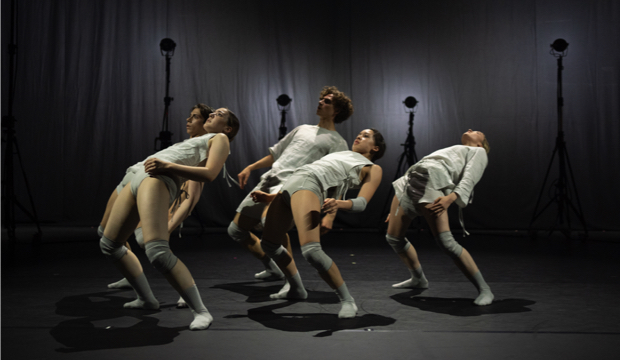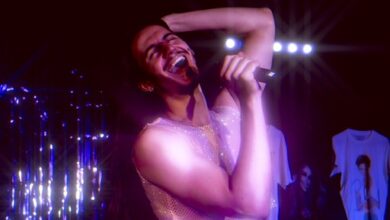Review: New English Ballet Theatre / Norwegian National Ballet 2, Linbury Theatre
In the “studio” of the Royal Opera House, sunken into the clay of Covent Garden the young, spritely dancers of The Next Generation Festival leap and lunge, in all their nauseating optimism.summary
Rating
Excellent
The Linbury is the smallest space in the Royal Opera House, and today youth abounds – the air positively glinting with it – as the Next Generation Festival highlights the work of early career dancers/choreographers, junior companies and dance schools.
Totalling eight shows, in this sliver we have a company from across the North Sea; Norwegian National Ballet 2, and New English Ballet Theatre from the closer, less glamorous Hammersmith.
NEBT begins with Matthew Ball’s Acts of Exaltation, a satisfying exploration of religious imagery and Renaissance/Baroque music. In diaphanous hooded robes, the first section is as if the Lord of the Ring’s Ringwraiths and the killer monks from The Da Vinci Code were asked to perform a ballet. Downcast spots and a warm background of orange plunge us into the cloister and religious motifs, fingers outstretched, David-esque. With arms curved up in penitence and eyes cast down, our friars dart around, morphing into shapes. A black shroud wafts like smoke from a swinging brazier. Claudio Monteverdi’s secular and religious music underline the duality, as quite suddenly disrobed we have Vestal Virgins glowing white, cavorting across the stage. Jerome Barnes as our master Abbot leads much of the early action, although all seven dancers understand the needed dower-faced grace.
NEBT’s second piece, choreographed by Daniela Cardim, is set to Bach. Crossing flamenco and the extras from The Fifth Element, futuristic red skirts and tight vests inform much of the action. Hunching over, they gather their folds then spring like mousetraps up into arabesque, spiralling into impressive pirouettes. The flare of flowing fabric brings much-needed drama to predictable choreography, but when stripped away to show odd mini-skirts underneath the bare legs (although kicking valiantly) distract rather than heighten.
Spiritedly inhabited by the dancers, I do question the originality of exploring religious and Baroque themes, both tried and tested stomping grounds for the genre. I mention this as our friends from the north fairly kick down the doors. Jahn-Magnus Johansen’s company is not only training for Norway National Ballet but striving for something new in a frenzied, ecstatic and sometimes messy way, most clearly in Anaïs Touret‘s new piece. In white pants, cotton vests and cropped hospital gowns the dancers shudder in lightning-crack lights. Large tripods surround them as they shake obsessively to a crashing industrial soundtrack. On the floor, backs arched, this piece is an exploration of anxiety, and mental instability: just what you want for a Sunday matinee.
The company proves it can do more classical classical with Kumiko Hayakawa’s Limerence. In Dusty, dusky and drab colours the dancers extend gleefully, lifting and rising together in a piece impressive if a little muted.
But their pushing of boundaries finds its limit in Sol Léon’s Step Lightly. To the shrieks and rhythmic chanting of Georgian/Eastern European folk music, clad in emerald dresses and peach peasant shirts, the dancers attempt a ballet-does-folk-dance to a woodland background. Lacking the military precision of the original genre rather exposes the dancers’ liquidity. Moments do jump out: a bashing of the head into the uplifted skirt, or the manhandling of one of the female dancers by a male, brutally feudal and futile. Giuseppe Ventura and Taeryeong Kim impress in all of the Norwegian pieces, especially Kim’s backward bending, swooping solo in Limerence.
Would you prefer a known path, though smooth, or the untrodden, but thorny? Questions for the choreographer, as an afternoon of more talented teenagers would be hard to find. The performers I witnessed slinking subterranean today will one day claw their way skyward like sleek, muscled little moles into the main space above, or to even dizzier heights. Putting aside my obvious jealousy, it is a distinguished festival and a fundamental stepping stone for the jewels of the ballet world’s future.
Companies involved in the festival are: BRNO National Theatre Ballet, Norwegian National Ballet 2, New English Ballet Theatre, The Royal Ballet School, All About Us (Chance to Dance Legacy Company, Chance to Dance Connect, The Royal Ballet School’s Primary Steps, National Youth Ballet and Joe Powell-Main), German National Youth Ballet (BundesJugendBallet), ZooNation Youth Company, Rambert School and English National Ballet School
The last performance of The Next Generation Festival is Thursday 4 July.
Further information and booking can be found here.







